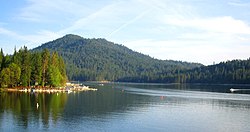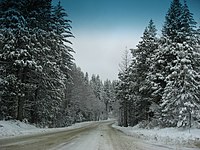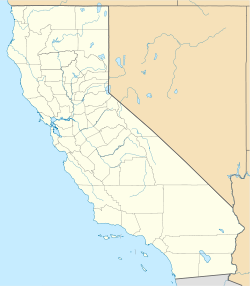Bass Lake, California
Bass Lake, California | |
|---|---|
 | |
 Location in Madera County, California | |
| Coordinates: 37°19′29″N 119°33′59″W / 37.32472°N 119.56639°W | |
| Country | United States |
| State | California |
| County | Madera |
| Named for | Bass Lake |
| Area | |
• Total | 2.49 sq mi (6.45 km2) |
| • Land | 1.88 sq mi (4.87 km2) |
| • Water | 0.61 sq mi (1.57 km2) 22.73% |
| Elevation | 3,415 ft (1,041 m) |
| Population | |
• Total | 575 |
| • Density | 305.53/sq mi (117.95/km2) |
| Time zone | UTC-8 (Pacific (PST)) |
| • Summer (DST) | UTC-7 (PDT) |
| ZIP Code | 93604 and 93669 |
| Area code | 559 |
| GNIS feature IDs | 256579; 2628709 |
| FIPS code | 06-04198 |
| Website | basslake-weather |
| U.S. Geological Survey Geographic Names Information System: Bass Lake, California; U.S. Geological Survey Geographic Names Information System: Bass Lake, California | |

Bass Lake is a census-designated place[4] in Madera County, California, United States.[2] It is located 4.5 miles (7.2 km) southeast of Yosemite Forks,[5] at an elevation of 3,415 feet (1,041 m).[2] The population was 575 at the 2020 census.[1]
Bass Lake is situated in the Sierra National Forest approximately 14 mi (23 km) from the south entrance of Yosemite National Park. Established in 1895 as "Bass Lake Village", the community grew up around the newly created Bass Lake reservoir that supplied the first hydroelectric generating project in Central California. Much of the community and the reservoir is devoted to the tourism industry.
The original post office at Bass Lake opened in 1912.[5]
The ZIP Codes for Bass Lake are 93604 and 93669, and it is in the 559 area code.
Geography
[edit]
According to the United States Census Bureau, the CDP has an area of 2.488 square miles (6.44 km2), 1.882 square miles (4.87 km2) of it land, and 0.606 square miles (1.57 km2) of it (24.36%) water.[1]

Demographics
[edit]| Census | Pop. | Note | %± |
|---|---|---|---|
| 2020 | 575 | — | |
| U.S. Decennial Census[6] 1850–1870[7][8] 1880-1890[9] 1900[10] 1910[11] 1920[12] 1930[13] 1940[14] 1950[15] 1960[16] 1970[17] 1980[18] 1990[19] 2000[20] 2010[21] | |||
At the 2010 census Bass Lake had a population of 527. The population density was 211.4 inhabitants per square mile (81.6/km2). The racial makeup of Bass Lake was 503 (95.4%) White, 1 (0.2%) African American, 10 (1.9%) Native American, 1 (0.2%) Asian, 0 (0.0%) Pacific Islander, 2 (0.4%) from other races, and 10 (1.9%) from two or more races. Hispanic or Latino of any race were 22 people (4.2%).[22]
The whole population lived in households, no one lived in non-institutionalized group quarters and no one was institutionalized.
There were 275 households, 30 (10.9%) had children under the age of 18 living in them, 138 (50.2%) were opposite-sex married couples living together, 19 (6.9%) had a female householder with no husband present, 9 (3.3%) had a male householder with no wife present. There were 16 (5.8%) unmarried opposite-sex partnerships, and 2 (0.7%) same-sex married couples or partnerships. 92 households (33.5%) were one person and 57 (20.7%) had someone living alone who was 65 or older. The average household size was 1.92. There were 166 families (60.4% of households); the average family size was 2.35.
The age distribution was 57 people (10.8%) under the age of 18, 18 people (3.4%) aged 18 to 24, 55 people (10.4%) aged 25 to 44, 169 people (32.1%) aged 45 to 64, and 228 people (43.3%) who were 65 or older. The median age was 62.3 years. For every 100 females, there were 86.9 males. For every 100 females age 18 and over, there were 84.3 males.
There were 1,059 housing units at an average density of 424.8 per square mile, of the occupied units 230 (83.6%) were owner-occupied and 45 (16.4%) were rented. The homeowner vacancy rate was 11.1%; the rental vacancy rate was 48.9%. 428 people (81.2% of the population) lived in owner-occupied housing units and 99 people (18.8%) lived in rental housing units.
References
[edit]- ^ a b c "2021 U.S. Gazetteer Files: California". United States Census Bureau. Retrieved June 24, 2022.
- ^ a b c U.S. Geological Survey Geographic Names Information System: Bass Lake, California
- ^ "P1. Race – Bass Lake CDP, California: 2020 DEC Redistricting Data (PL 94-171)". U.S. Census Bureau. Retrieved June 24, 2022.
- ^ U.S. Geological Survey Geographic Names Information System: Bass Lake, California
- ^ a b Durham, David L. (1998). California's Geographic Names: A Gazetteer of Historic and Modern Names of the State. Clovis, Calif.: Word Dancer Press. p. 743. ISBN 1-884995-14-4.
- ^ "Decennial Census by Decade". United States Census Bureau.
- ^ "1870 Census of Population - Population of Civil Divisions less than Counties - California - Almeda County to Sutter County" (PDF). United States Census Bureau.
- ^ "1870 Census of Population - Population of Civil Divisions less than Counties - California - Tehama County to Yuba County" (PDF). United States Census Bureau.
- ^ "1890 Census of Population - Population of California by Minor Civil Divisions" (PDF). United States Census Bureau.
- ^ "1900 Census of Population - Population of California by Counties and Minor Civil Divisions" (PDF). United States Census Bureau.
- ^ "1910 Census of Population - Supplement for California" (PDF). United States Census Bureau.
- ^ "1920 Census of Population - Number of Inhabitants - California" (PDF). United States Census Bureau.
- ^ "1930 Census of Population - Number and Distribution of Inhabitants - California" (PDF). United States Census Bureau.
- ^ "1940 Census of Population - Number of Inhabitants - California" (PDF). United States Census Bureau.
- ^ "1950 Census of Population - Number of Inhabitants - California" (PDF). United States Census Bureau.
- ^ "1960 Census of Population - General population Characteristics - California" (PDF). United States Census Bureau.
- ^ "1970 Census of Population - Number of Inhabitants - California" (PDF). United States Census Bureau.
- ^ "1980 Census of Population - Number of Inhabitants - California" (PDF). United States Census Bureau.
- ^ "1990 Census of Population - Population and Housing Unit Counts - California" (PDF). United States Census Bureau.
- ^ "2000 Census of Population - Population and Housing Unit Counts - California" (PDF). United States Census Bureau.
- ^ "2010 Census of Population - Population and Housing Unit Counts - California" (PDF). United States Census Bureau.
- ^ "2010 Census Interactive Population Search: CA - Bass Lake CDP". U.S. Census Bureau. Archived from the original on September 2, 2013. Retrieved July 12, 2014.
- "Bass Lake History". BassLakeCA.com. 2009. Archived from the original on February 25, 2009. Retrieved March 13, 2009.
- "History, Then and Now..." Oakhurst Area Chamber of Commerce. 2009. Archived from the original on February 13, 2009. Retrieved March 13, 2009.
- "Bass Lake (Crane Valley)". Madera County, California GenWeb. December 21, 2008. Retrieved March 13, 2009.



